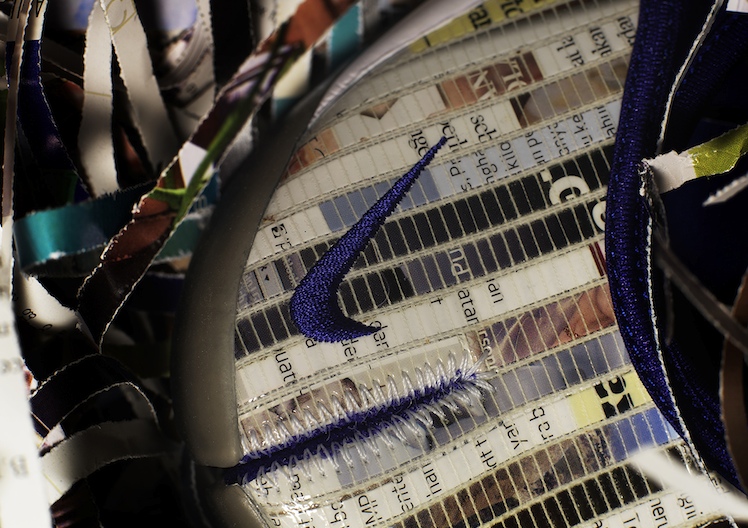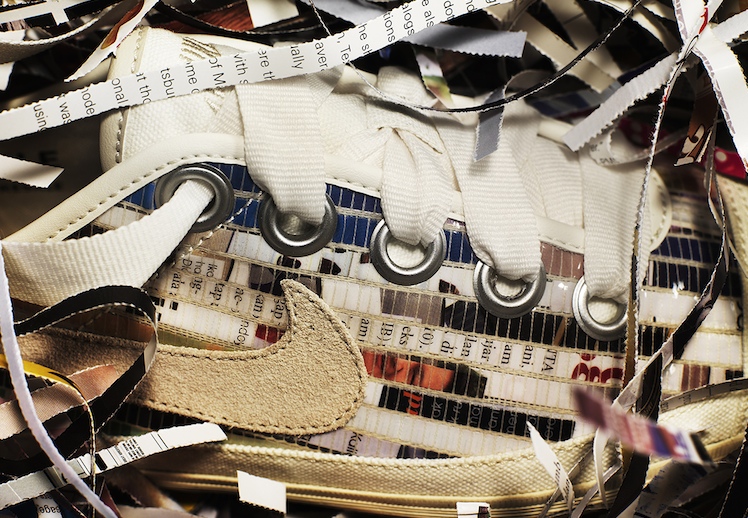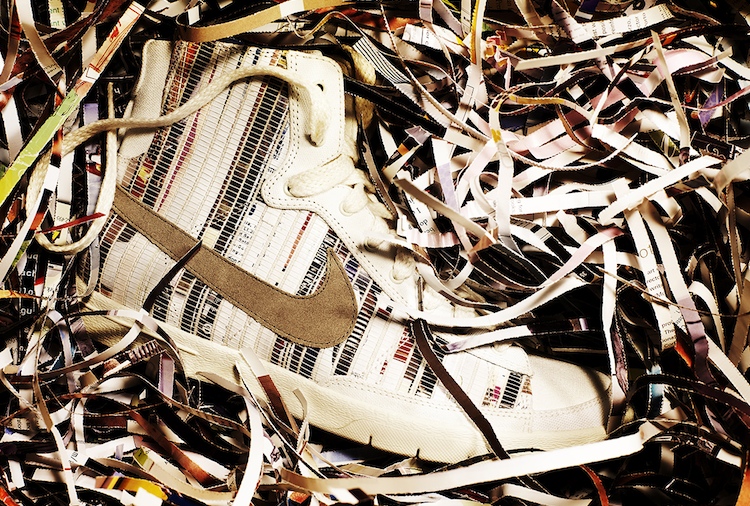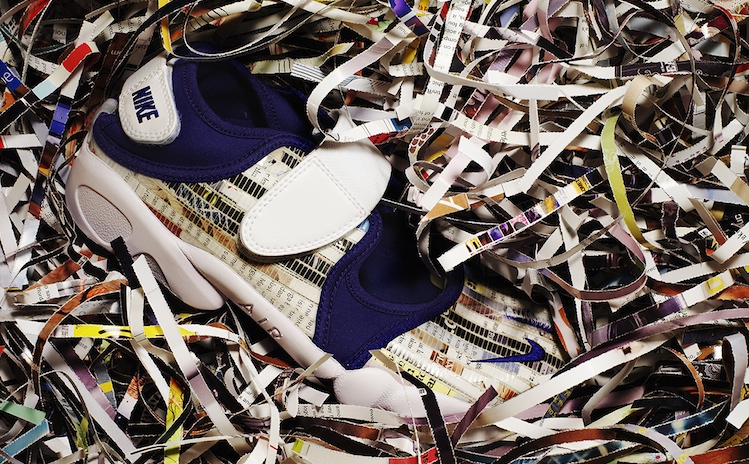The Future of Print? Nike Makes Shoes From Shredded Magazines
A limited edition of sneakers made from recycled magazines, released in select emerging markets._________________________________________________________________________________If print is dead, it's getting a hell of a reincarnation in these killer kicks from Nike.What do you do with all those stacked-up, unread New Yorkers on your nightstand? Recycle 'em, of course. Maybe if they're lucky, they'll end up with an afterlife as cool as the Nike Women's Premium Print Pack, a limited edition set of sneakers designed out of shredded magazines. Snag a pair of these, and you won't need to feign interest in that 10,000-word article on Balinese maskwork when you crash a publishing soiree -- you can just wear your media-elite street cred.
The Print Pack contains three Nike styles: The Nike Flash Macro Premium (sail/birch), Nike Blazer Mid Premium (sail/khaki) and Nike Air Rift Premium (sail/sport red). But don't sweat those details, because according to Nike, unless you live in Europe, China, or "select emerging markets," you don't have a chance in hell of getting your hands on them.
No, you must admire the Print Pack's retro-chic bricolage from the digital remove of this blog: from the delicate stitching of these bits of deathless prose (or ad copy, more likely) into unique patterns on each shoe, to the rugged transparent coating that protects the literary moments-in-amber from the elements that buffet any footwear worn outside the redoubts of obscure underground clubs or European runway shows. (Pretty good, right? Maybe Nike can turn my disposable hackwork into rad kicks someday!)
Credit where credit is due: the design of these sneaks is pretty great. The bits of print look like vintage filmstrips running up and down the shoes' clean lines. And who knows, maybe there are whole narratives to be discovered in the cut-up fragments adorning your feet. Crazier things have happened -- just ask Jonathan Safran Foer.
The Women's Premium Print Pack will "debut in limited quantities" starting January 1.
[Images courtesy of Nike]
Art in RGB makes 3-in-1 Wall Décor
Gorgeous color blast in food styling
Concept for a Critter Bridge
Inexpensive wooden bridges covered with native vegetation, as proposed by landscape design firm Balmori Associates, if implemented, could reduce the number of U.S. car-animal collisions and their cleanup cost of $US 8 billion annually.
Flashy Neon Type Tutorial
Neon type effect tutorial, The Revolution Artwork, by Aoiro Studio. View tutorial.
Typographic Tree
Helvetica Cookies
Stefan Sagmeister: Functionality is Optional, but Honesty is Key
Innovative designer Sagmeister shares his views on graphic design, including its role to translate non-visual messages into visual communications.
Related:
Referenced: Bauhaus movement. See brief historical context.
See Sagmeister's studio home page, which utilizes a webcam feed with clickable menu on the floor of the studio.
Visionary Renaissance Images
Renaissance-flavored, and Renaissance-like in that multi-platform skills are applied, photographer Christian Tagliavini acts as author, set designer, costume designer and director to achieve these unique images.
Typographic Poster presents Difficult World Facts
Typographic variety give these difficult facts a visual edge, making them more interesting than the plain text emails of this message that have been circulating for some time.
Foldable, Rubber Stool
Baked Objects
Via Deezen.
3 Product Designs striving to change habits for the better
It's the mundane, oft-repeated habits of our times that create the most waste, cumulatively generating landfills at an alarming rate. Here are three product design and product packaging ideas that strive not only to reduce waste, but also to address ease of use, thereby encouraging behavioral consumer changes.
Paperboard's line of Ditto hangers for home or business help make a dent against the 3.5 billion wire hangers and 8 billion plastic hangers that end up in landfills. The 17" ziggurat hanger model (image 2), which was designed for Adidas and holds 20 pounds, has a 1" wide shoulder and is perfect for holding even delicate fabrics such as knits—an award-winning design available in packs of 10 for $15 via Amazon.
For Starbucks' 2010 Betacup Challenge competition, which invited designers to create cups that encouraged waste-reducing behaviors, Dutch designer Martjin van Loon came up with an edible solution: a heat resistant and liquid resistant wafer cup which can be disposed of by being eaten.
ECOvention's GreenBox pizza box is tri-purpose: pizza suitcase, plates, and compact storage box. The top folds down into four pre-perforated plates, cutting back on paper plate use, and the bottom folds into a compact storage, eliminating the need for an additional storage container or wrap. It's already used at Whole Foods in the U.S., Ali Baba Pizza in Canada, and other locations, and has been honored at the Responsible Packaging Awards on October 14, 2010, Boston.
Maps of Stereotypes
Image 1: Europe according to the U.S.
Image 2: Europe according to Germany
Image 3: Europe according to Britain
Image 4: The Word according to the U.S.
Image 5: Italy according to Italians
These colorful, appealing maps can easily be construed as either funny or offensive, or both—depending, naturally, on one's own geographic point of view. The World according to the USA, Europe according to Great Britain, Italy according to Italians, and many other maps show funny yet accurate stereotypical thinking of "the others." Wearable as T-shirts, they invite humorous provocation and an acknowledgement of the costs and foolishness of the ever-present contests and strifes between humans—or the like.
These are a great reminder that beautiful visuals can be created for any purpose, and that graphic design and other visual works are created in the context of cultural environment, political motivation, or economic purpose... be it a religion, a social movement, a hedonistic appeal, nationalistic pride, etc.—especially good reminders during election cycles or when evaluating infographics.
From Alphadesigner.
Thanks to SandroP for sharing this find.
The Avantgarde in Visual History
The first half of the 20th Century laid a notable foundation to visual communication as we know it today. Across the west, influential artists, photographers, and architects sought to influence culture, break from the past and react to expansive wars. In the process, they marked the development of graphic design and its cousin design fields.
The term "Avant-Garde" was coined in Paris in 1863 in reference to a small group of artists and intellectuals who opened new cultural paths for society. By the early 1900s this kind of artistic influence was evolving across Europe.
At the onset of World War I, the Russian Constructivist movement emerged as a way to utilize art as an instrument with social goals—a movement with notable influence thought the middle of the century. While in Russia the artistic and architectural Constructivist movement sought to lay the foundations of a socialist system, in Milan, the Futurist movement took hold, whereby all mediums of art from sculpture to photography were deployed in an effort to reject the past and embrace the ideals of technology, speed, youth and violence—visible influences to this day, especially in film and pop culture.
In Germany, the Bauhaus movement, whose foundation lay in the 1880s modernism movement, strove to unify art, craft and technology, resulting in an art and architectural ideal that welcomed machines and spanned across industrial and product design, and became the foundation for contemporary graphic design education.
QB Conference bot steps up telecommuting
With simple keyboard controls, this little robot can roll into a meeting and sit, turn to follow a speaker, roll out of the room to follow cooler dialogue, display video on its forehead, use a built-in laser pointer—pretty much anything to enable a remote colleague to participate in communications on a job site, be they formal or informal, as long as they're accessible by wheels and within an 8-hour battery life.
The cute bot has its clear limitations, but it's an improvement over the bigger and more limited formalities of common video conferences, where discussions are bound by an arbitrary length of time, static tables, chairs, and screens, organizational hierarchy, and other formal constructs that constrain the exchange of thoughts to a formula that is not always the source of the ideas that drive an organization. Since many productive ideas are generated at informal places like the break room, cafeteria or colleague's offices, the QB's ability to follow people and conversations from one place to another is very useful.
QB is made by Anybots, who envisions a coming reduction in business travel and its carbon footprint.
















































































